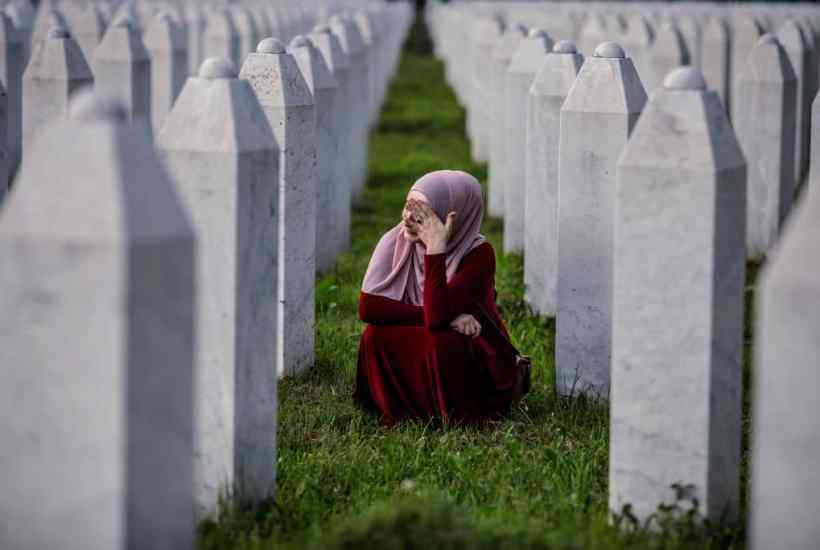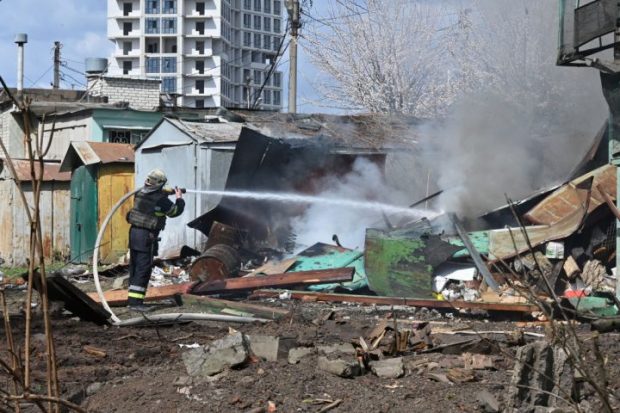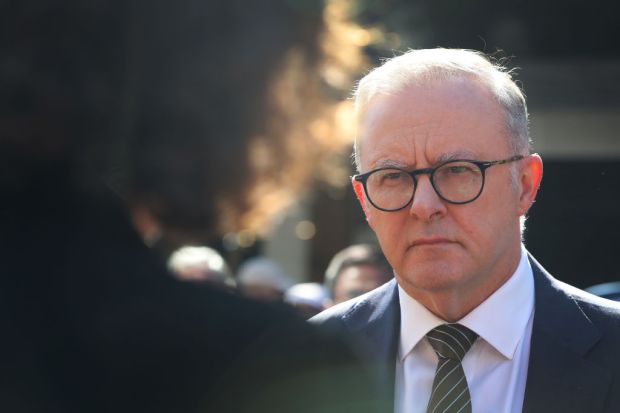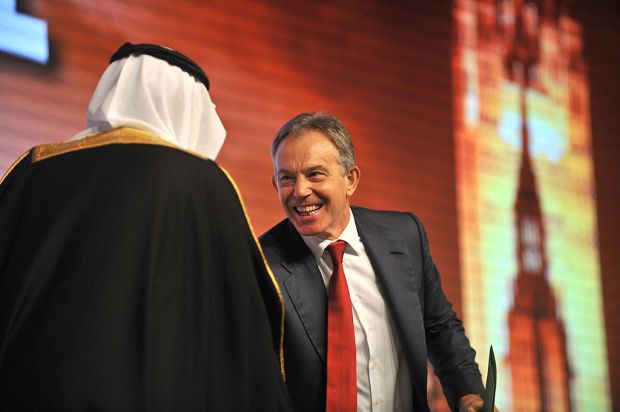High on a hillside not far from the eastern Bosnian town of Srebrenica the remains of dozens of young Muslim men had been left to rot.
By the time I found them most of the flesh had been eaten away by forest scavengers – bears, wolves, foxes and even stray dogs – but the skeletons and skulls remained, some with rags of clothing and scraps of hair still attached.
Personal possessions lay among the remains: tobacco tins – one inscribed with the name Suljo, a pair of broken glasses, family photographs. Most of these photoswere taken with Polaroid cameras – a status symbol in the old Yugoslavia. Theblack backings had peeled away but the faces were still visible, if faded.
This week as locals began to gather bodies and exhume mass graves in Bucha and other suburbs around Kyiv, Ukrainian officials accused the Russian army of carrying out another ‘Srebrenica’.
The scale is, of course, vastly different. The Serbs machine-gunned around 8,000 Muslim men in three days in July 1995, in what amounted to the worst mass killing on European soil since world war two.
The estimates, so far, are that in the Kyiv suburbs several hundred died.
But given the relentless shelling, bombing and medieval-style blockades that Moscow is imposing elsewhere in Ukraine the numbers of victims must surely be climbing fast.
The bloodiest of the city sieges – carried out against Mariupol, a 440,000-strong city on the Black Sea – has left thousands dead, local officials say, although the numbers are impossible to verify.
As a cub reporter I was dispatched to Bosnia by my newspaper as that war was ending. The conflict, which began 30 years ago today, had lasted three and a half years and claimed around 100,000 lives.
Most of the dead were civilians, and the vast majority of those Bosnian Muslims.
I set out in the late spring of 1996 in a rented Lada Niva to try and find the bodies from Srebrenica. We had all heard reports of the massacre but no one knew for sure where the bodies were.
A local Serb, during a drunken night in a bar in the suburbs of Sarajevo, had told me to seek out a radio journalist in a small eastern Bosnian town called Vlasenica.
‘He will tell you where the bodies are, if he wants to…’ he said.
I tracked down the journalist, an unattractive middle-aged man with a voluminous pot-belly.
He loathed his Muslim neighbours, but he loved meat and home-made brandy and so, day after day, I listened to his tales about Serb victimhood down the ages and bought him lunch, dinner and drinks.
And then, one day, he sat back in his chair and looked at me with resignation. ‘So. You want to see the bodies from Srebrenica,’ he said.
For a while we drove northeast, passing through tiny communities, each with the burned-out husks of homes where Muslims had once lived. Finally he directed me up a forestry trail, little wider than the car. As the trail got steeper, we began to hit patches of snow and the car started slipping. I began to get nervous.
And then, just as I was about to suggest we turn around, at the top of a short rise, I saw a decayed human body lying across the road. By now the track was so steep that I didn’t dare stop the car in case we slid backwards. I gritted my teeth and drove over the corpse, feeling a small thud.
As soon as I could I stopped the car. We got out. And there were the bodies.
Bandage packs, small glasses of penicillin powder and empty cans of European Union food rations were scattered around some. A pocket edition of the Koran lay near another.
I gingerly dug out identity cards from some of the pockets of the dead men.
A few were still legible and carried the names of Srebrenica Muslim men, mostly aged between 20 and 30. Mustafa Sehic, born Aug 1, 1973, in Srebrenica, had met his end here. So had Vahdet Alic born Jan 8, 1969.
The decayed bodies were scattered over several acres. Skulls and skeletons gleamed on the grass in the late afternoon, spring sunshine.
I walked around checking the bodies. Then after about half an hour we headed back down. And it was there, at the bottom of the hill, I noticed a long agricultural shed.
‘Can I look inside?’ I asked my guide. ‘Why do you want to look?’ he asked.
‘Because the UN says that hundreds of civilians were lined up and shot in just such a shed in this very village,’ I replied honestly.
‘They are lying,’ he said angrily.
‘I believe you, of course,’ I replied. ‘But if you want me to write that for my newspaper I have to take a look.’
I walked over to the building and peered into the gloom. There was nothing unusual. And then, just as I was about to leave, I looked again at the holes in the wall.
I realised with a start they were bullet holes. And then I understood that the irregular splatters of what I had taken to be mud, were actually blood.
I later found out that war crimes investigators concluded that 1,300 Muslims had been shot in this nondescript shed.
Returning to the car, I got back in and began to drive. For a few minutes there was a tense silence.
Then my Serb guide turned to me and said with a sneer: ‘So. I was right, wasn’t I? There is nothing there.’
Last month I returned to Srebrenica for the first time in more than 20 years.
As we drove across the snowy mountains to the east of Sarajevo, the Russians were blocking access to humanitarian aid into Ukrainian cities they were besieging, just as the Serbs had once blocked access to Srebrenica.
Russians on television were calling the Ukrainians ‘Fascists’ and claiming they were helping de-Nazify the Ukrainian nation, just as the Serbs had once called the Bosnian Muslims ‘Turks’, and claimed their women – who they nevertheless raped on an industrial scale – smelled of sheep fat.
I stopped at the agricultural shed. Little had changed. The blood had gone but the bullet holes were still there and only a thin strand of barbed wire marked off the area, which had apparently been sold to a local farmer.
A few hundred yards down the road, in contrast, a large gaudy concrete memorial had been erected to the local Serb victims of the war, replete with its own small amphitheatre.
When the Bosnian war started three decades ago few imagined the horrors that lay ahead. But perhaps most striking is the flat denial among the aggressors that they have done anything wrong.
When photographs and videos of the killings at Bucha were broadcast this week the Russian government simply put out a statement saying the images were all fakes.
And almost every Bosnian Serb I spoke to during my recent trip to Bosnia – and there were many – said that Srebrenica was not a genocide.
‘It clearly can’t be a genocide, we didn’t kill the women and children,’ one man told me, echoing the sentiments of many others.
When I asked at the Srebrenica memorial centre how many Serbs ever came to visit, the man in charge pursed his lips. ‘Almost none,’ he said.
Got something to add? Join the discussion and comment below.
Get 10 issues for just $10
Subscribe to The Spectator Australia today for the next 10 magazine issues, plus full online access, for just $10.
Julius Strauss runs the newsletter Back to the Front about Russia, Ukraine, Afghanistan and the Balkans.

















Comments
Don't miss out
Join the conversation with other Spectator Australia readers. Subscribe to leave a comment.
SUBSCRIBEAlready a subscriber? Log in